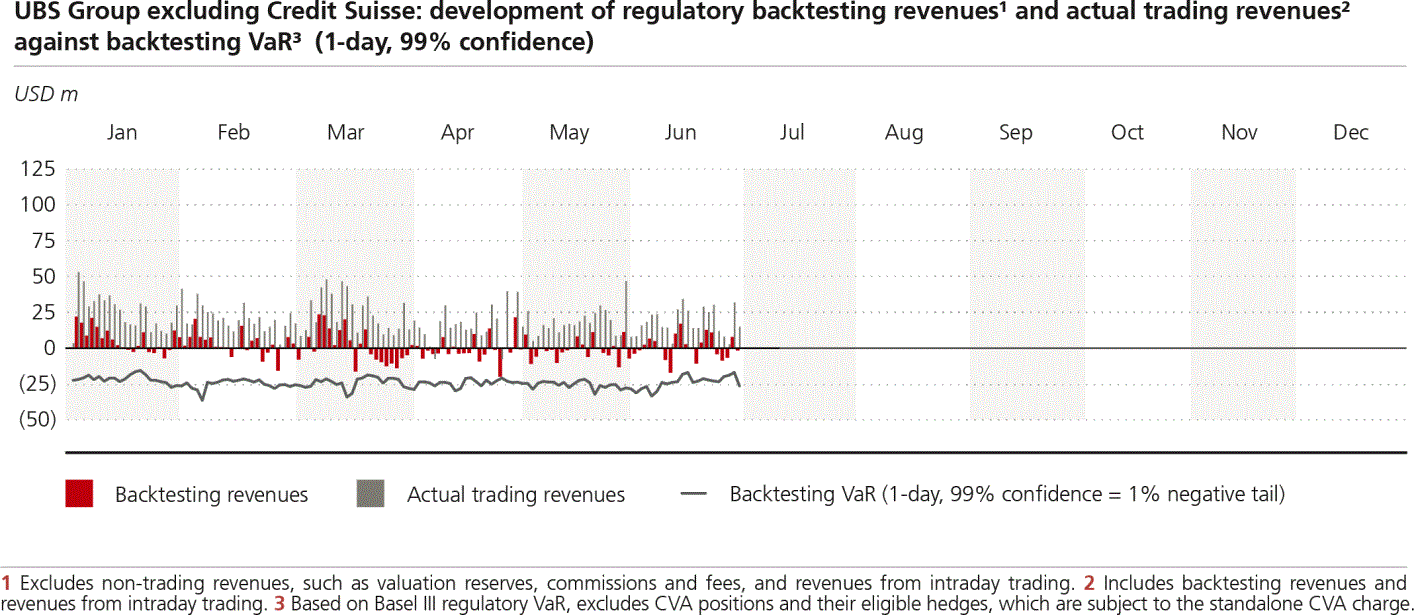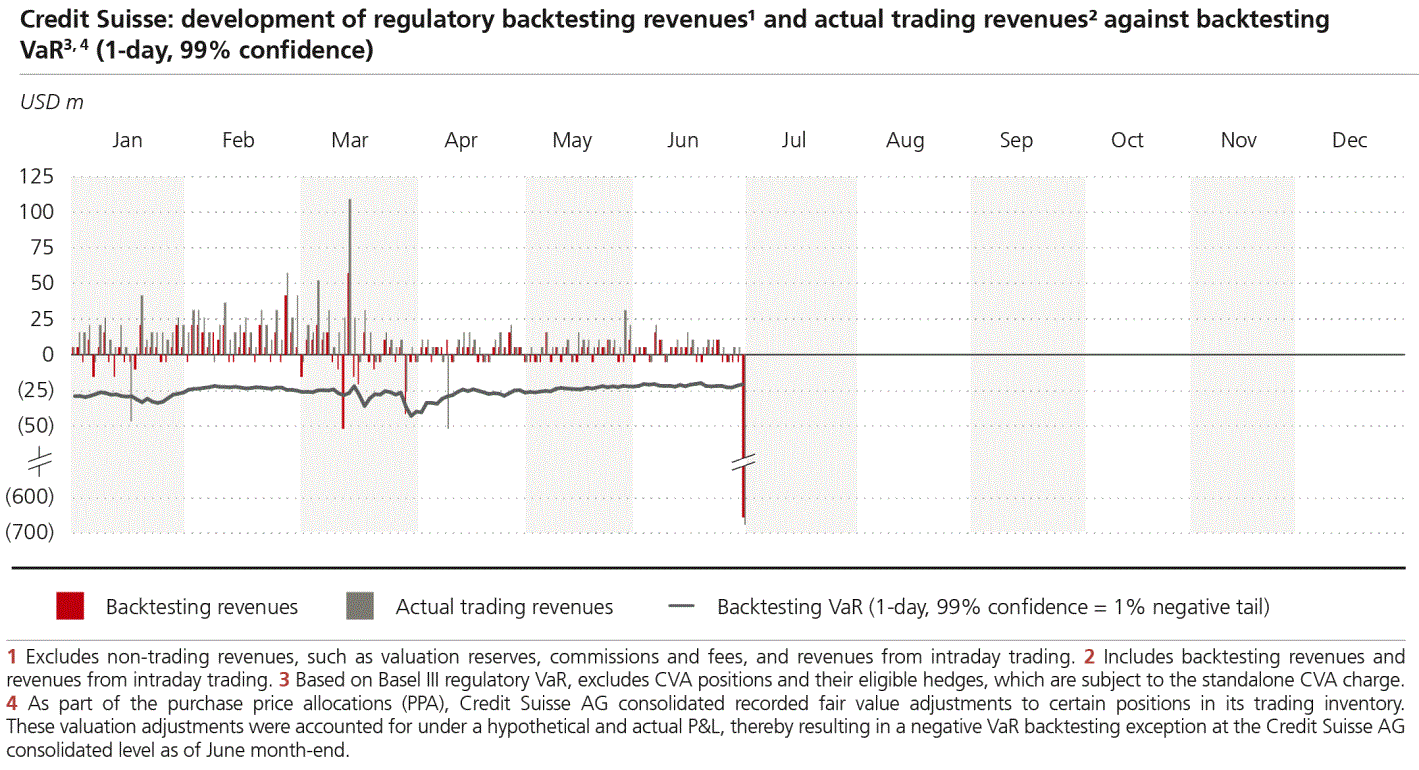30 June 2023 Pillar 3 Report |
UBS Group | Going and gone concern
requirements and eligible capital
43
CC1: Composition of regulatory capital (continued)
As of 30.6.23
References
1
USD m, except where indicated
Additional Tier 1 capital: instruments
30
Directly issued qualifying additional Tier 1 instruments plus related stock
surplus
31
Of which: classified as equity under applicable accounting
standards
32
Of which: classified as liabilities under applicable accounting
standards
34
Additional Tier 1 instruments (and CET1 instruments not included in row 5) issued
by subsidiaries and held by third parties (amount allowed
in
group AT1)
36
Additional Tier 1 capital before regulatory adjustments
Additional Tier 1 capital: regulatory adjustments
37
Investments in own additional Tier 1 instruments
5
38
Reciprocal cross-holdings in additional Tier 1 instruments
38a
Qualified holdings where a significant influence is exercised
with other owners (AT1 instruments)
38b
Immaterial investments (AT1 instruments)
39
Investments in the capital of banking, financial and insurance entities
that are outside the scope of regulatory consolidation, where
the bank
does not own more than 10% of the issued common share capital
of the entity (amount above 10% threshold)
40
Significant investments in the capital of banking, financial
and insurance entities that are outside the scope of regulatory
consolidation
41
Other adjustments
42
Regulatory adjustments applied to additional Tier 1 due to insufficient
Tier 2 to cover deductions
42a
Regulatory adjustments applied to CET1 capital due
to insufficient additional Tier 1 to cover deductions
43
Total regulatory adjustments to additional Tier 1 capital
44
Additional Tier 1 capital (AT1)
45
Tier 1 capital (T1 = CET1 + AT1)
Tier 2 capital: instruments and provisions
46
Directly issued qualifying Tier 2 instruments plus related stock surplus
6
48
Tier 2 instruments (and CET1 and AT1 instruments not included in rows 5 or 34) issued by
subsidiaries and held by third parties (amount
allowed in group Tier 2)
50
Provisions
51
Tier 2 capital before regulatory adjustments
Tier 2 capital: regulatory adjustments
52
Investments in own Tier 2 instruments
5
53
Reciprocal cross-holdings in Tier 2 instruments and other TLAC liabilities
Qualified holdings where a significant influence is exercised
with other owners (T2 instruments and other TLAC instruments)
53b
Immaterial investments (T2 instruments and other TLAC
instruments)
54
Investments in the capital and other TLAC liabilities of banking, financial
and insurance entities that are outside the scope of regulatory
consolidation, where the bank does not own more than 10%
of the issued common share capital of the entity (amount
above 10% threshold)
55
Significant investments in the capital and other TLAC liabilities
of banking, financial and insurance entities that are outside
the scope of
regulatory consolidation (net of eligible short positions)
56
Other adjustments
56a
Excess of the adjustments, which are allocated to the AT1 capital
57
Total regulatory adjustments to Tier 2 capital
58
Tier 2 capital (T2)
59
Total regulatory capital (TC = T1 + T2)
60
Total risk-weighted assets
Capital ratios and buffers
61
Common Equity Tier 1 (as a percentage of risk-weighted assets)
62
Tier 1 (as a percentage of risk-weighted assets)
63
Total capital (as a percentage of risk-weighted assets)
64
Institution-specific buffer requirement (capital conservation buffer
plus countercyclical buffer requirements plus higher
loss absorbency
requirement, expressed as a percentage of risk-weighted assets)
7
65
Of which: capital conservation buffer requirement
66
Of which: bank-specific countercyclical buffer requirement
67
Of which: higher loss absorbency requirement
68
Common Equity Tier 1 (as a percentage of risk-weighted assets) available after
meeting the bank’s minimum capital requirements
Amounts below the thresholds for deduction (before risk weighting)
72
Non-significant investments in the capital and other TLAC liabilities of
other financial entities
73
Significant investments in the common stock of financial entities
74
Mortgage servicing rights (net of related tax liability)
75
Deferred tax assets arising from temporary differences (net of
related tax liability)
Applicable caps on the inclusion of provisions in Tier 2
76
Provisions eligible for inclusion in Tier 2 in respect of exposures subject
to standardized approach (prior to application of cap)
77
Cap on inclusion of provisions in Tier 2 under standardized approach
78
Provisions eligible for inclusion in Tier 2 in respect of exposures subject
to internal ratings-based approach (prior to application of cap)
79
Cap for inclusion of provisions in Tier 2 under internal ratings-based approach
1 References link the lines of this table to the respective reference numbers provided in
the “References” column in the “CC2: Reconciliation of accounting balance sheet
to balance sheet under the regulatory scope
of consolidation” table in this section.
2 IFRS netting for deferred tax
assets and liabilities is reversed
for items deducted from CET1
capital.
3 Includes USD 803m in compensation-related charge
for regulatory
capital purposes.
4 Includes USD 4,897m related to transitional CET1 purchase
price allocation adjustments. Refer to the “Key
metrics” section of this report for more information.
5 Under IFRS, debt issued and
subsequently repurchased is treated as
extinguished.
6 Consists of own instruments
held and 45% of the gross
unrealized gains on debt instruments
measured at fair value through
other comprehensive income,
which are measured at the lower of cost or market value for regulatory capital purposes.
7 BCBS requirements are exceeded by our Swiss SRB requirements. Refer to the “Capital, liquidity and funding, and balance
sheet“ section of the Annual Report 2022, available under ”Annual reporting” at ubs.com/investors,
for more information about the Swiss SRB requirements.
p



